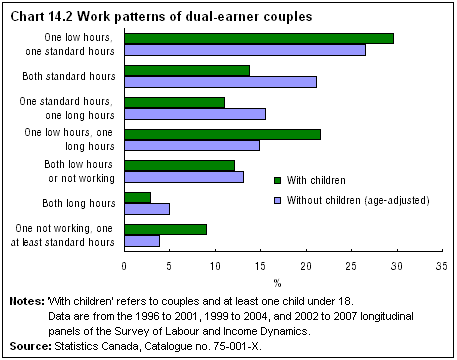Families, households and housing
Archived Content
Information identified as archived is provided for reference, research or recordkeeping purposes. It is not subject to the Government of Canada Web Standards and has not been altered or updated since it was archived. Please "contact us" to request a format other than those available.
Related information
The past 20 to 30 years have seen many married and common-law families with children transform from single-earner households to ones where both parents work to contribute to the household income. This increase in the amount of time couples spend working outside the home has been fuelled by economic need and by greater participation of women in the labour force. Many women are staying in school longer and working in jobs that require advanced skills, prompting them to delay the start of their families.
More women are waiting until their 30s and 40s to have their first child. In 2005, 11% of all first births were to women aged 35 and older, almost triple the proportion in 1987. The number of mothers of preschoolers (ages 0 to 4) who are in their early 40s has more than doubled over the last 20 years. Of the 1.3 million women aged 40 to 44 in 2006, about 9%, or 117,100, were mothers of at least one preschooler, compared with 4% in 1986.
The professional and economic situation of these women is different from that of women who have their children earlier. In 2006, nearly 14% of women aged 40 to 44 who had a bachelor's degree were mothers of a young child, compared with 6% of women of the same age who had a high school diploma or less. For women who had a doctorate, the proportion was 20%. About 30% of women aged 40 to 44 who had young children were in a professional occupation that required a bachelor's degree or a higher level of certification.
More dual-earner couples
The total weekly employment hours of all couples has increased 13% from an average of 58 hours in 1976 to 65 hours in 2008, or by one full day of paid work per week. However, this trend masks a change in the type of family (from single-earner to dual-earner), even though the average hours for each type have not changed. In other words, more families today have two earners, but the combined time that dual-earner couples spend at work has remained stable at around 77 hours per week.
The proportion of families with children at home under the age of six who were dual-earners has more than doubled from 31% in 1976 to 67% in 2008, while the labour force participation rate for mothers with young children has doubled from 37% to 74%.
The increase in family work hours has not necessarily translated into similar living standards for all families. From 1980 to 2005, increases in family work hours generally translated into higher financial gains for most families, but increases in rates of pay—or in hourly wages—were mostly limited to families at the top of the earnings distribution.

View data source for chart 14.1
Work patterns differ
The average number of hours wives work has steadily increased, whereas husbands' hours have fallen. Among dual-earners with children at home under the age of six, wives' hours increased from 32 in 1997 to 34 in 2008; husbands' hours declined from 44 to 42. However, in many families with children, at least one parent (usually the mother) still spent less time in a paid job than the other parent.
- Date modified:

